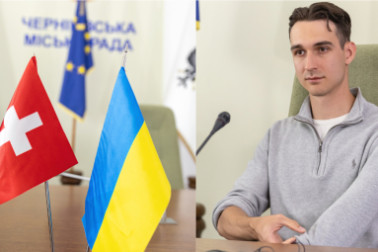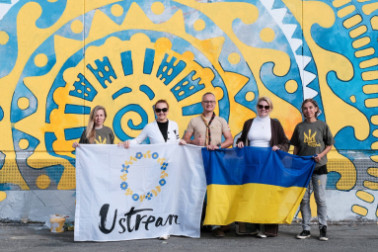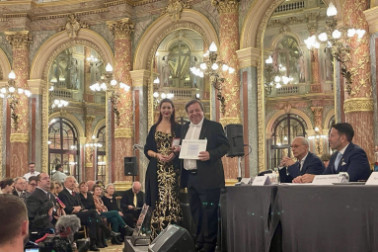DestiNation.ua continues to tell the stories of outstanding Ukrainian women who have gained worldwide recognition and significantly contributed to their field. Today, we will talk about the Ukrainian artist Sonia Delaunay. This famous abstract artist became the first woman in history to have a solo exhibition at the Louvre. She was also a fashion designer with a unique recognizable style, dressing celebrities, owning boutiques in Paris and Madrid, and even having one of her "optical" dresses featured on the cover of Vogue.
As is often the case with prominent figures from Ukraine, Sonia Delaunay is claimed as a Russian artist in Russia, but the artist herself identified with Ukraine:
"I love the pure, bright colors of my childhood, Ukraine. I remember the rural weddings in my country, where red and green dresses adorned with numerous bows danced. I remember how watermelons and tomatoes ripen, red roofs decorate the houses, and large sunflowers - yellow with black hearts - shine in the light, high blue sky," the artist recalled.
Sonia Delaunay's paintings, fabrics, and clothing are infused with Ukraine - the vibrant colors, the plasticity of forms, the unique rhythm, and the combination of colors bring us back to her memories of her homeland and our perception of Ukraine.
.jpg) From Hradysk to Paris
From Hradysk to Paris
Sonia Delaunay's real name was Sara Stern. She was born in the town of Hradysk in the Poltava region of Ukraine. Still, her family moved to Odessa when she was young, so Sonia is often called an Odessite.
She lost her parents at a young age, which led her to move to St. Petersburg because her maternal uncle lived there and took Sara and her brother into his family. Her uncle was a wealthy man with a successful law practice. As a result, the children received a good education. They had the opportunity to travel the world, including visits to some of the world's most famous museums.
Sara had exceptional analytical abilities, and her relatives believed she would become a mathematician. However, according to one version, her drawing teacher quickly recognized her talent as a gifted artist with a highly original world vision. It was he who strongly advised her to focus on art education. Sara changed her name to Sonia Terk and immersed herself in painting. Among her uncle's friends was the German Impressionist artist Max Liebermann, who, as historians suggest, gifted her with her first professional paints.
.jpg)
At age twenty, Sonia moved to Europe to continue her artistic education. She studied at the Academy of Fine Arts in Germany and the La Palette Art Academy in Paris. However, she found the classical academies too critical and outdated for her taste, as she had a keen sense of new artistic trends. Consequently, she pursued further education in various studios. She spent her time exploring the art galleries of Paris, searching for her own unique style.
At the age of 23, Sonia married a German critic and collector named Wilhelm Uhde, who had his own art gallery and introduced his wife to the world of the artistic elite. However, the artist left her husband within a year and married a young abstractionist named Robert Delaunay. That's when Sonia Terk became Sonia Delaunay, and she gave birth to her son, Charles, immersing herself further in the world of creativity.
.jpg) The Birth of Orphism
The Birth of Orphism
Interestingly, the new "Delaunay" avant-garde art style emerged thanks to motherhood. One day, Sonia stitched together a quilt of different colored patches in a patchwork style for her son. She felt that there was room for further development in this direction. She immersed herself in experiments with geometry and color. Her husband also joined her in these explorations. Through their joint efforts and creative enthusiasm, Sonia eventually gave birth to a new style of art called Simultaneism. When the French poet and artist Guillaume Apollinaire, a friend of the Delaunay family, saw Sonia's works, he called her style "Orphism," likening it to the music of Orpheus.
One of the distinctive features of Delaunay's style was the optical illusion of movement, rhythm, and dynamics that arose when bright colored spots of various sizes and shapes were juxtaposed.
Sonia also applied these principles when creating fabrics and clothing.
.jpg) Fashion and Theater
Fashion and Theater
In 1914, due to the outbreak of World War I, Sonia and her husband moved from Paris to Spain. By then, she had already established herself as a prominent avant-garde fashion designer, quickly gaining popularity in her new country. In 1918, she opened her fashion house, Casa Sonia, and later opened branches in Bilbao, Barcelona, and San Sebastian. This helped support her family during the difficult war years.
In 1921, the family returned to Paris, where Sonia, continuing her successful business, opened a fashion house called Delaunay and later a large "Simultaneist boutique" where a wide range of clothing in the Simultaneist style with large colorful patterns was showcased.
During this time, she attracted many celebrity clients, including Hollywood actress Gloria Swanson, writer Nancy Cunard, architect Ernő Goldfinger, and others. She was also invited to work in the theater, designing costumes and sets for Diaghilev's ballet "Cleopatra."
.jpg) Peak of Popularity
Peak of Popularity
In 1925, the "Simultaneist boutique" Delaunay and a vast collection of Simultaneist products became part of the Paris Exhibition of Decorative Arts. All these dresses, carpets, swimsuits, shawls, and even cars with abstract patterns in the Simultaneist style generated immense interest, even among leading fashion magazines, including Vogue, which once featured a "Simultaneist" cover.
In many ways, it was thanks to Sonia Delaunay that the Art Deco style, which combined elements of modernism and avant-garde, became dominant in interwar fashion. Sonia became a highly respected expert and taught art history at the Sorbonne. She is still considered a leading figure in the Art Deco style, which she enriched by inventing her own direction in art.
In 1964, more than twenty years after her husband's death, a joint exhibition of their works, featuring 117 paintings personally selected and donated by Sonia to France, was held at the Louvre. This exhibition was a significant event in the country's art scene.
1975 Sonia Delaunay was awarded the highest French honor, the Legion of Honour.
Over her long life, she created many artistic works, from shawls to cars, decorated performances and major exhibition centers, and practically created without limits. However, she could never return to her homeland. The fate of the artist's family, which remained in the Soviet Union, was rather tragic. Her brother died in a Soviet prison camp on the Solovetsky Islands after fifteen years of imprisonment. The aunt who raised her lived in poverty in her final years. Sonia's house in St. Petersburg, her inheritance, was nationalized.
After her death, Polish newspapers wrote that a prominent Ukrainian, Sonia Delaunay, had passed away. The French emphasized her Frenchness and only Ukrainians were unaware for a long time of their brilliant compatriot - an innovative artist who could never return home but learned to express her sense of Ukraine in her works.







